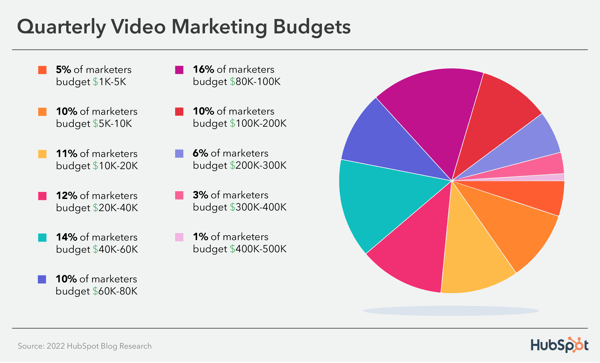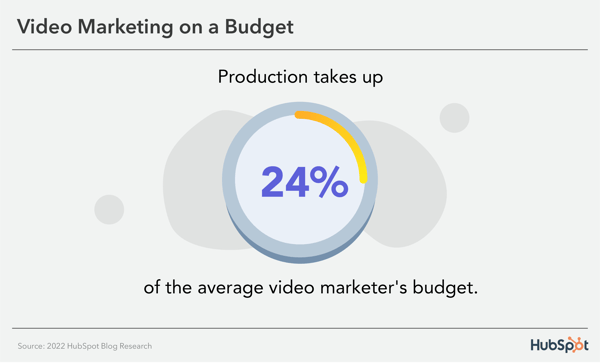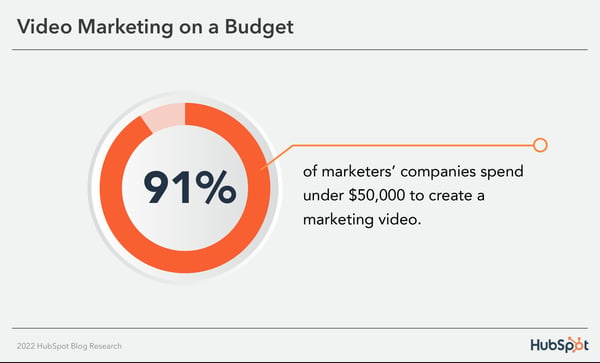![How Brands are Investing in Video Marketing On a Budget [2022 Data]](https://www.liveseo.com/wp-content/uploads/2022/06/How-Brands-are-Investing-in-Video-Marketing-On-a-Budget.jpgkeepProtocol.jpeg)
According to 2022 HubSpot Blog Research, 31% of video marketers surveyed say their biggest challenge is having an inadequate budget to create video content.
In this article, we’ll cover what it costs to run a video marketing campaign and what brands are investing in the most this year.
How much are marketers spending on video marketing?
This year, we wanted to learn more about how marketers approach video marketing, including the strategies they leverage, the returns they get, and the amount they invest.
We surveyed over 500+ global marketers and here’s what we discovered.
Firstly, the data suggests that video marketing is a top content format for brands – with 31% of marketers surveyed allocating 21 to 40% of their total marketing budget to video.
Another 30% allocate 41 to 60% of their total budget to video marketing.
Video is so important that 52% of marketers say their budget increased in 2022. However, the increase is more present in B2B brands.
Now, when it comes to quarterly budgets, here’s the breakdown:

- Many brands have a conservative budget with 15% of respondents allocating only $1K and $10K.
- 11% of marketers surveyed budget $10K and 20K.
- The most popular budget bracket is between $20K and $60K, followed by 26% of marketers surveyed.
- On the higher end, 16% of marketers surveyed say they allocate $80K to 100K while 20% invest between $100K and $200K.
- Only a small percentage of companies surveyed (10%) budget over $200K.
Now that you know how much marketers are investing in video marketing, let’s break down how they’re spending it.
What are video marketers spending their budget on?
When asked, “Which part of the video creation process is most expensive?” 65% of marketers surveyed answered production.

Production is the process of filming your content and setting up the equipment needed to capture the footage, such as lighting, audio, and props.
According to marketers surveyed, production takes up 24% of the average video marketer’s budget.
Pre-production (ideation, scripting, casting) and post-production (editing and exporting) are tied as the second-highest cost. Then it’s tied again between the cost of video production and distribution and on-camera talent.
On average, 91% of marketers surveyed say they spend under $50,000 to create a marketing video.

Most (53%) say they spend under $10,000 and 16% spend under $1,000. Only a small percentage of respondents say they spend over $100K.
Video Marketing Techniques to Use on a Budget
1. Weigh your options.
According to our video marketing data, 69% of video marketers surveyed own production equipment while 10 percent rent, and the remaining group does both.
There’s an argument to be made for both.
On one end, creating videos in-house can be cheaper. However, outside agencies can provide higher-quality content.
In fact, most smaller brands (those with 200 employees or less) believe creating video content through an outside agency offers a better ROI than doing so in-house.
However, across all business sizes, roughly a third of respondents say the ROI is about the same either way.
With that said, it’s important to weigh your options and assess when and what you should rent versus own.
Upon first look, it might seem like renting is the smarter (and more affordable) option. However, most marketers surveyed (58%) say creating content in-house is cheaper.
To make this decision, consider the type of content you’ll be producing and the equipment you’ll need.
This is key in determining what is more cost-efficient.
If you’re a makeup brand for instance, you can probably produce great content sitting in front of a camera simply showcasing your products in action with good lighting. However, if you’re a travel and hospitality brand, you’ll likely need props, on-camera talent, location, and many more elements to fulfill your vision. In this case, it may be cheaper to outsource.
2. Separate need-to-haves from must-haves.
When it comes to video equipment, there will always be bigger and better out there.
If there’s one area you should focus on, it’s lighting.
Many believe that having the best camera does the trick but the truth is, lighting is what makes or breaks the quality of a video.
Lighting sets the tone and mood of a video, two elements you need to maintain your audience’s attention in a video.
Sound is another area to splurge on – specifically your mics. This will enhance the quality of your video, especially if you have to settle for low-end cameras.
As for everything else, (the camera, the lens, the accessories), these are great add-ons but if you’re on a budget, you can make do with low to mid-range options while still getting a high-quality result.
3. Leverage user-generated content.
According to HubSpot Blog Research, the number one challenge video marketers face is a lack of time to create video content.
Well, who said you had to create your content from scratch? You’re likely sitting on a pile of content from your customers right now.
If you have a strong social media presence, you likely have a bank of user-generated content ranging from images to videos and text. You can leverage all of these for campaigns and use them to supplement your own content.
For instance, ahead of the official Fenty Beauty perfume launch, its founder and musician Rihanna posted what seemed to be an ad.
It was a video compilation of various celebrities and influencers mentioning how good she smells – “like heaven” was a phrase heard multiple times.
just sayin’ 🤷🏿♀️… pic.twitter.com/EmC4ysMdjR
— Rihanna (@rihanna) August 10, 2021
Without ever having to produce their own video, the brand leveraged UGC to build anticipation surrounding this launch.
4. Hire student and amateur talent.
When it comes to on-camera talent, this is where brands often struggle to think of alternatives.
They usually opt for an in-house creator just to save money, even though their role may not focus on this area at all. Or they contract talent, which can be costly.
Here’s a third option: Reach out to students and amateur actors.
In some cases, money isn’t the main motivator. It can often be exposure, gaining experience, or building up a portfolio. However, paid opportunities will always generate more interest and can get you more experienced talent.
5. Use free editing software.
When you think of video editing, the first thing that comes to mind is probably Adobe.
It’s the go-to software for production professionals. However, it’s complex and isn’t affordable. If you own an Apple device like the Macbook or iPad, you will have free video editing software already available.
While it doesn’t have as many features and offers limited functionality, it works well for simple editing and you can always find workarounds on platforms like YouTube.
Some free editing software comes with free music or you can find online websites that offer royalty-free music.
If you’re intimidated by the idea of video marketing because you think you don’t have the funds, hopefully, these five techniques will change your mind.
Video marketing is an important part of content creation and can drive sales so don’t let money prevent you from staying in the game.
Editor’s Note: This post was originally published in March 2016 and has been updated for comprehensiveness.


![HubSpot's 2025 State of Blogging Report [Data from 500+ Marketers]](https://www.liveseo.com/wp-content/uploads/2025/02/HubSpots-2025-State-of-Blogging-Report-Data-from-500-Marketers.webp-300x300.webp)


